Digital Posters
Model-Based Reconstruction
ISMRM & SMRT Annual Meeting • 15-20 May 2021

| Concurrent 1 | 15:00 - 16:00 |
1172.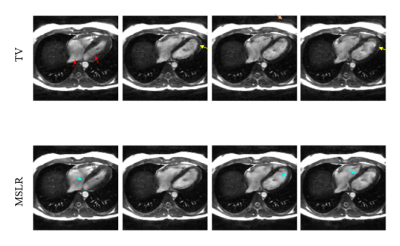 |
Multi-Scale Low-Rank Reconstruction for Phase-Cycled Projection-Reconstruction bSSFP Cardiac Cine and BMART-Generated B0 Maps
Anjali Datta1, Dwight Nishimura1, and Corey Baron2
1Electrical Engineering, Stanford, Stanford, CA, United States, 2Medical Biophysics, Western University, London, ON, Canada
For banding-free bSSFP cardiac cine, a highly-accelerated projection-reconstruction sequence acquires three phase-cycles within a short breathhold. Data is also acquired on the rewinds, enabling generation of B0 maps using BMART, which are used for phase-cycle combination. We show that this data is well-captured by a multi-scale low-rank (MSLR) model, which recovers the normal and rewind images from the aggressively-undersampled data with less streaking and blurring than total-variation-regularized ESPIRiT. In addition to improving the phase-cycle component images, MSLR facilitates generation of temporally-resolved B0 maps with good SNR. Together, these two improvements result in the final, field-map-combined cine images having high quality.
|
|||
1173. |
Simplified Phase-Sensitive Inversion Recovery (PSIR) Reconstruction using Multi-dimensional Integration (MDI) for Elevated SNR
Yichen Hu1 and Junpu Hu2
1UIH America, Inc., Houston, TX, United States, 2United Imaging Healthcare, Shanghai, China
We applied MDI algorithm to classic PSIR reconstruction for cardiac imaging and demonstrated the feasibility and effectiveness of the approach for improved SNR in phase-sensitive contrast imaging. In comparison to the conventional reconstruction, the algorithm offers a simplified and fast pathway to achieve desired image contrast. Improved SNR in the T1W images in comparison to the conventional PSIR reconstruction was obtained.
|
|||
1174.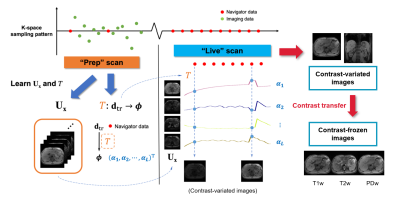 |
Single ProjectIon DrivEn Real-time (SPIDER) Multi-contrast MR Imaging Using Pre-learned Spatial Subspace
Pei Han1,2, Junzhou Chen1,2, Fei Han3, Zhehao Hu1,2, Debiao Li1,2, Anthony G. Christodoulou1,2, and Zhaoyang Fan1,4
1Biomedical Imaging Research Institute, Cedars-Sinai Medical Center, Los Angeles, CA, United States, 2Department of Bioengineering, UCLA, Los Angeles, CA, United States, 3Siemens Medical Solutions USA, Inc., Los Angeles, CA, United States, 4Departments of Radiology and Radiation Oncology, University of Southern California, Los Angeles, CA, United States
We propose SPIDER, a new technique for real-time multi-contrast 3D imaging. A “Prep” scan is first performed to learn the static information; a “Live” scan is then performed to acquire only single k-space projection for dynamic information. With the information learned in the “Prep” scan, 3D multi-contrast images can be generated with simple matrix multiplication, which yields a latency of 50ms or less.
|
|||
1175.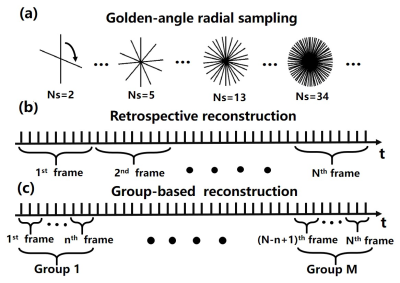 |
Low-rank and Framelet Based Sparsity Decomposition for Reconstruction of Interventional MRI in Real Time
Zhao He1, Ya-Nan Zhu2, Suhao Qiu1, Xiaoqun Zhang2, and Yuan Feng1
1Institute for Medical Imaging Technology, School of Biomedical Engineering, Shanghai Jiao Tong University, Shanghai, China, 2School of Mathematical Sciences, MOE-LSC and Institute of Natural Sciences, Shanghai Jiao Tong University, Shanghai, China
A low-rank and sparsity (LS) decomposition algorithm with framelet transform was proposed for real-time interventional MRI (i-MRI). Different from the existing LS decomposition, we exploited the spatial sparsity of both the low-rank and sparsity components. A primal dual fixed point (PDFP) method was adopted for optimization to avoid solving subproblems. We carried out intervention experiments with gelatin and brain phantoms to validate the algorithm. Reconstruction results showed that the proposed method can achieve an acceleration of 40 folds.
|
|||
1176.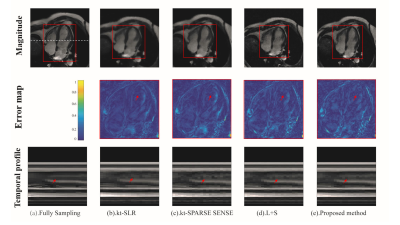 |
Reconstruction of Undersampled Dynamic MRI Data Using Truncated Nuclear Norm Minimization and Sparsity Constraints
Runyu Yang1, Yuze Li1, and Huijun Chen1
1Center for Biomedical Imaging Research, Department of Biomedical Engineering, Tsinghua University, Beijing, China
Achieving high spatio-temporal resolutions is challenging in dynamic magnetic resonance imaging (dMRI). It is effective to use low-rank prior and sparse prior jointly for dMRI reconstruction. In this study, we proposed a novel method used low rank prior which utilize a nonconvex norm and sparse prior jointly for dMRI reconstruction. The effectiveness of the proposed method was investigated in phantom and in-vivo experiments.
|
|||
1177.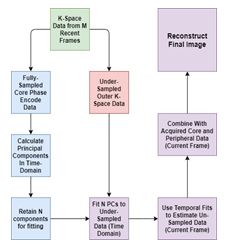 |
Time Domain Principal Component Analysis for Rapid, Real-Time MRI Reconstruction from Undersampled Data
Mark Wright1, Bryson Dietz1, Jihyun Yun1,2, Eugene Yip2, B Gino Fallone1,2, and Keith Wachowicz1,2
1Oncology, University of Alberta, Edmonton, AB, Canada, 2Medical Physics, Cross Cancer Institute, Edmonton, AB, Canada
A real-time acceleration method using Principal Component Analysis (PCA) was developed for use on hybrid MR-radiotherapy machines. Using principal components representative of the temporal changes of k-space in combination with incoherently undersampled data from past dynamic frames, the missing data from the current undersampled frame can be filled in. This allows for real-time fully-reconstructed images. Retrospective analysis on 15 fully-sampled lung cancer patients was used to test the method. Using metrics such as NMSE, pSNR and SSIM, image quality and temporal-robustness was assessed. Dice coefficient, centroid displacement and Hausdorff distance were used to test auto-contouring capabilities for target tracking effectiveness.
|
|||
1178.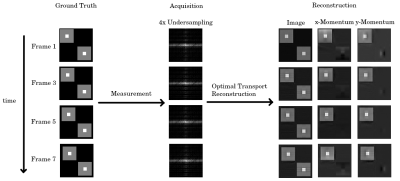 |
Optimal Transport Based Convex Hybrid Image and Motion-Field Reconstruction
Ingmar Middelhoff1, Matthias Schlögl2, Adrián Martín Fernández3, Silvio Fanzon4,5, Kristian Bredies4,5, and Rudolf Stollberger1,5
1Institute of Medical Engineering, TU Graz, Graz, Austria, 2Solgenium OG, Linz, Austria, 3Department of Information and Communications Technologies, Pompeu Fabra University, Barcelona, Spain, 4Institute of Mathematics and Scientific Computing, NAWI Graz, University of Graz, Graz, Austria, 5BioTechMed-Graz, Graz, Austria
In this study we present an approach that combines sub-sampled encoding reconstruction and simultaneous object motion computation. For that purpose Optimal Transport is used as convex regularization for motion-afflicted measurements. It reconstructs explicit pixel-wise motion fields simultaneously to the image series. Results based on simulated data show that 8-frame image series can be reconstructed in great detail from 4-fold undersampled k-space series data from a single coil. The high potential of the presented method could be shown for the reconstruction of undersampled image series. For the recovery of the motion fields, further improvements are still necessary.
|
|||
1179.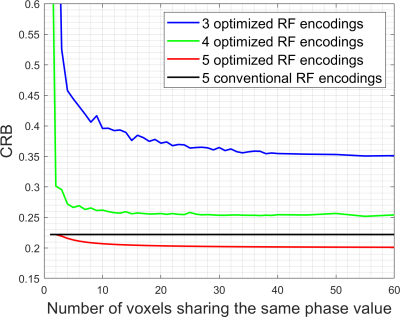 |
Accelerating gSlider-based Diffusion MRI: Phase constraints enable reduced RF encoding
Yunsong Liu1, Kawin Setsompop2, and Justin P. Haldar1
1Signal and Image Processing Institute, University of Southern California, Los Angeles, CA, United States, 2Department of Radiology, Stanford University, Stanford, CA, United States
gSlider is an efficient technique for diffusion MRI that uses multiple RF encodings to encode high-resolution spatial information along the slice dimension. In this work, we investigate whether smooth-phase constraints can be used to reduce the required number of RF encodings. Although smooth-phase constraints are classically used to reduce k-space sampling (partial Fourier acquisition), we believe that their use to reduce RF encoding requirements is novel. Theoretical and simulation results demonstrate that, if optimized RF encodings are used, phase constraints can successfully be used to reduce the number of required RF encodings in image regions where the phase is smooth.
|
|||
1180.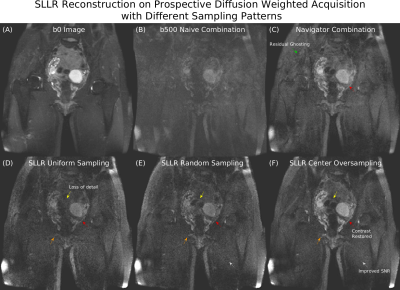 |
Improved Sampling for Distortionless Diffusion Weighted 2D Cartesian Multi-Shot Fast Spin Echo
Philip Kenneth Lee1,2, Yuxin Hu1,2, Catherine Judith Moran2, Bruce Lewis Daniel2, and Brian Andrew Hargreaves1,2,3
1Electrical Engineering, Stanford University, Stanford, CA, United States, 2Radiology, Stanford University, Stanford, CA, United States, 3Biomedical Engineering, Stanford University, Stanford, CA, United States
In diffusion weighted imaging, multi-shot Echo Planar Imaging (EPI) is preferred over single-shot EPI due to reduced geometric distortion. Recent work has shown that low-rank reconstructions can correct ghosts from shot-to-shot phase without explicitly acquiring a phase navigator. These works have been limited to EPI sampling trajectories with uniform ky sampling. 2D Cartesian Fast Spin Echo (FSE) is a distortionless alternative to multi-shot EPI that has greater freedom in k-space traversal and reduced chemical shift artifacts. Using FSE, we demonstrate in simulation and in vivo that an intelligent choice of sampling pattern greatly enhances image quality in multi-shot diffusion imaging.
|
|||
1181.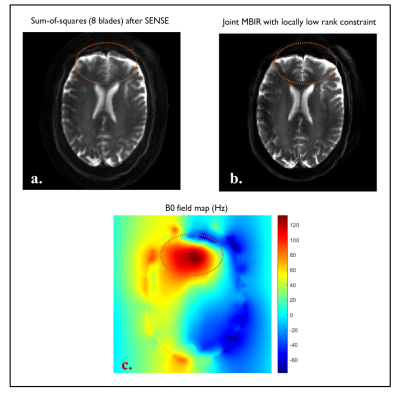 |
Model-Based Iterative Reconstruction for Short-Axis Propeller EPI at 7T MRI
Uten Yarach1,2, Frank Godenschweger3, Matt A Bernstein2, Myung-Ho In2, Itthi Chatnuntawech44, Kawin Setsompop5, Oliver Speck3, and Joshua Trzasko2
1Radiologic Technology Department, Associated Medical Sciences, Chiang Mai University, Chinag Mai, Thailand, 2Department of Radiology, Mayo Clinic, Rochester, MN, USA, Rochester, MN, United States, 3Otto-von-Guericke University Magdeburg, Biomedical Magnetic Resonance, Magdeburg, Germany, 4National Nanotechnology Center (NANOTEC), National Science and Technology Development Agency (NSTDA), Bangkok, Thailand, 5Department of Radiology, Stanford University, Stanford, CA, United States
Short-Axis Propeller (SAP) EPI enables short echo spacing, thereby minimizing geometric distortion, while providing low resolution in the readout direction of single blades. These multiple low-resolution blades can be combined to create a final high-resolution image. However, off-resonance effect often results in blurring after blade combination. In this work, we extend a model-based framework for reconstructing SAP-EPI to minimize off-resonance induced blurring artifacts. Moreover, locally low rank (LLR) regularization is incorporated to estimate per-blade phase calibrations. As a result, the proposed technique enables high-resolution SAP-EPI images with minimizing blurring artifact and no need for phase calibration of different multi-blade directions.
|
|||
1182.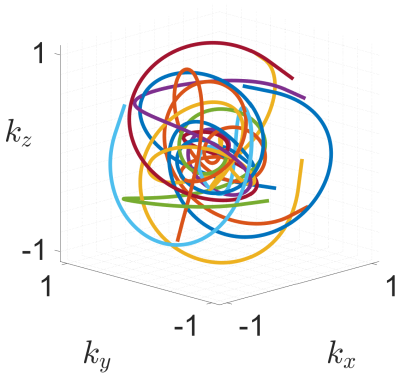 |
On the possibility of reconstructing arbitrary FOVs using gradient waveforms with low-coherent aliasing properties
Tobias Speidel1, Patrick Metze1, Kilian Stumpf1, Thomas Hüfken1, and Volker Rasche1
1Internal Medicine II, Ulm University Hospital, Ulm, Germany
The calculation of k-space trajectories in MRI usually involves prior knowledge of the FOV, since the desired FOV defines a minimum k-space sampling density. The reconstruction of a FOV which is larger than what is represented by the primary sampling density is equal to undersampling in k-space. Arising artefacts are strictly dependent on the underlying k-space trajectory, which leads to advantages for k-space trajectories with low-coherent aliasing properties, also for the combination with non-linear reconstruction techniques. Based on a generalised form of the "Seiffert-Spirals", this abstract describes an imaging modality that does not require prior commitment to an imaging FOV.
|
|||
1183.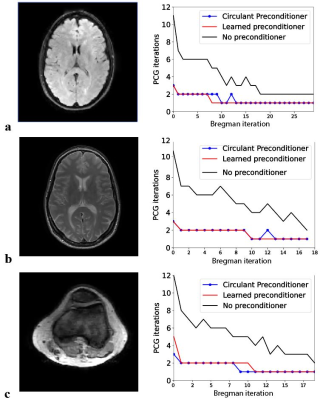 |
Learning a Preconditioner to Accelerate Compressed Sensing Reconstructions
Kirsten Koolstra1 and Rob Remis2
1Division of Image Processing, Leiden University Medical Center, Leiden, Netherlands, 2Circuits and Systems, Delft University of Technology, Delft, Netherlands
Long reconstruction times of compressed sensing problems can be reduced with the help of preconditioning techniques. Efficient preconditioners are often not straightforward to design. In this work, we explore the feasibility of designing a preconditioner with a neural network. We integrate the learned preconditioner in a classical reconstruction framework, Split Bregman, and compare its performance to an optimized circulant preconditioner. Results show that it is possible for a learned preconditioner to meet and slightly improve upon the performance of existing preconditioning techniques. Optimization of the training set and the network architecture is expected to improve the performance further.
|
|||
1184.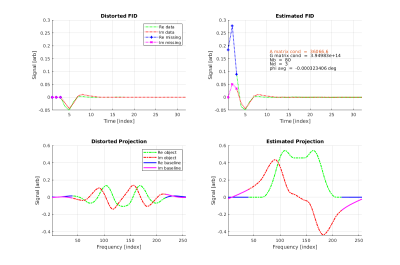 |
Robust and Computationally Efficient Missing Point and Phase Estimation for Zero Echo Time (ZTE) Sequences
Curtis A Corum1,2, Abdul Haseeb Ahmed2, Mathews Jacob2, Vincent Magnotta2, and Stanley Kruger2
1Champaign Imaging LLC, Shoreview, MN, United States, 2University of Iowa, Iowa City, IA, United States FID sequences such as the zero echo time sequence (ZTE) posses many advantages including capturing signals from fast relaxing spins, efficient use of time and quite acoustic operation. They possess one major disadvantage, information from the start of the FID is nearly always missing or corrupted due to requirements for RF pulse time and T/R switching (ZTE) and gradient ramping (UTE). Here we modify and apply for the first time a robust and computationally efficient missing point and phase estimation algorithm originating in the solid state NMR community for ZTE imaging sequences. |
|||
1185.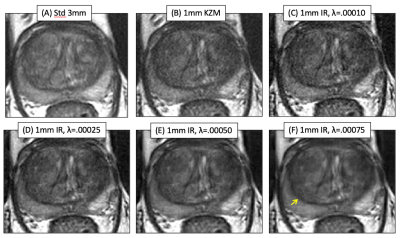 |
Iterative Reconstruction for Enhanced Through-Plane Resolution T2-Weighted Spin-Echo Imaging of the Prostate
Eric A Borisch1, Roger C Grimm1, Soudabeh Kargar2, Akira Kawashima3, Joshua D Trzasko1, and Stephen J Riederer1
1Radiology, Mayo Clinic, Rochester, MN, United States, 2Radiology, University of Wisconsin-Madison, Madison, WI, United States, 3Radiology, Mayo Clinic, Phoenix, AZ, United States
A previously described method for producing an image stack with enhanced through-plane resolution from an acquired set of overlapping thicker 2D slices is limited by noise enhancement when a linear reconstruction is used. To improve the resulting sharpness and noise performance of the output images, a sparsity-regularized (wavelet) full forward model based iterative reconstruction is developed. Initial results with a composite-splitting gradient descent solver provide promising noise and resolution enhancement performance. Future work includes refinements to the forward model and improving optimization convergence of the solver through momentum-based algorithms.
|
|||
1186.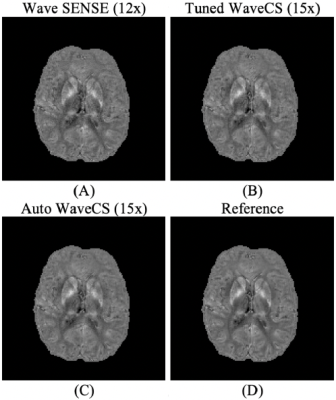 |
Automatic WaveCS reconstruction
Gabriel Varela-Mattatall1,2 and Ravi S Menon1,2
1Centre for Functional and Metabolic Mapping, Robarts Research Institute, Western University, London, ON, Canada, 2Department of Medical Biophysics, Schulich School of Medicine and Dentistry, Western University, London, ON, Canada
WaveCS is the combination of corkscrew trajectories in k-space with the application of compressed sensing reconstruction. However, its accurate reconstruction depends critically on user-defined tuning. This is a tedious process that may require additional optimization if acquisition parameters are changed. Furthermore, an incorrect regularization weighting could generate noise amplification, emergence of artifacts, smoothing and loss of structural information. Here, we present a fast, non-iterative and automatic procedure that estimates the regularization weighting and which reconstruction is comparable to previous reconstructions using more tedious approaches that are considered the state-of-the-art.
|
|||
1187.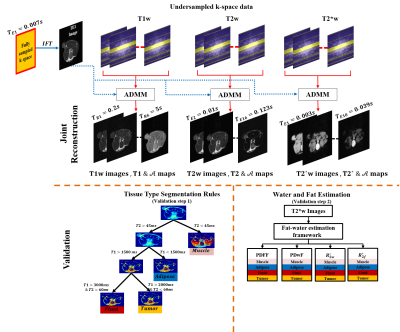 |
Jointly Reconstructed Undersampled Multiparameter MRI for Imaging Intratumoral Subpopulations
Shraddha Pandey1,2, Arthur David Snider1, Wilfrido Moreno1, Harshan Ravi2, Ali Bilgin3, and Natarajan Raghunand2,4
1Electrical Engineering, University of South Florida, Tampa, FL, United States, 2Cancer Physiology, Moffitt Cancer Center, Tampa, FL, United States, 3Departments of Medical Imaging, Biomedical Engineering, and Electrical & Computer Engineering, University of Arizona, Tucson, AZ, United States, 4Department of Oncologic Sciences, University of South Florida, Tampa, FL, United States
A joint reconstruction framework is proposed to reconstruct a series of T1-weighted, T2-weighted, and T2*-weighted images and corresponding parameter maps simultaneously from undersampled cartesian k-space data. Joint Total Variation (JTV) and model-based constraints were employed to resolve the ambiguity introduced due to undersampling. T1 and T2 maps were used to identify fluid, adipose, muscle and tumor tissue types. T2*w images reconstructed from undersampled data were analyzed to produce maps of Proton Density Fat Fraction (PDFF), Proton Density Water Fraction (PDwF), and the relaxation rates of water ($$$R^*_{2w}$$$) and fat ($$$R^*_{2f}$$$) in each tissue type [1].
|
|||
1188.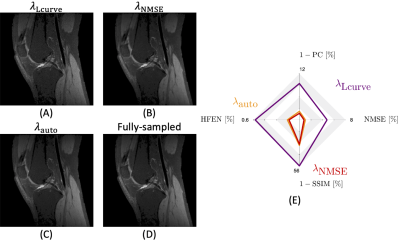 |
Automatic determination of the regularization weighting for wavelet-based compressed sensing MRI reconstructions
Gabriel Varela-Mattatall1,2, Corey A Baron1,2, and Ravi S Menon1,2
1Centre for Functional and Metabolic Mapping, Robarts Research Institute, Western University, London, ON, Canada, 2Department of Medical Biophysics, Schulich School of Medicine and Dentistry, Western University, London, ON, Canada
Most compressed sensing reconstruction procedures have relied on user-defined tuning and/or multiple comparisons to the fully sampled data to demonstrate both the feasibility of compressed sensing reconstructions as the appropriate selection of the regularization weighting. Obviously, this is a time-consuming procedure which could be avoided if we had a method that provides the regularization weighting in an automatic, non-iterative, prospective, and fast manner. Here, we present such method that could significantly accelerate research that is based on compressed sensing and improve its clinical translatability when the sparsifying domain is based on the wavelet transform.
|
|||
1189.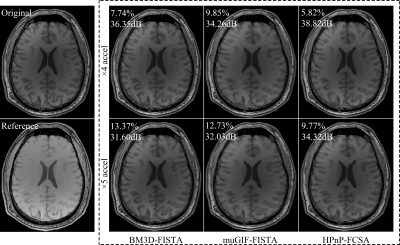 |
Improved CS-MRI using Hybrid Plug-and-Play Priors based Fast Composite Splitting Algorithm
Qingyong Zhu1, Jing Cheng2, Zhuo-Xu Cui1, and Dong Liang1,2
1Research Center for Medical AI, SIAT, Chinese Academy of Sciences, Shenzhen, China, 2Paul C. Lauterbur Research Center for Biomedical Imaging, SIAT, Chinese Academy of Sciences, Shenzhen, China
The Plug-and-Play prior (PnP) is also known as denoising prior which has been successfully utilized in non-linear imaging problems. The paper presents a hybrid PnP which is incorporated into the fast composite splitting algorithm (FCSA) for compressed sensing magnetic resonance imaging (CS-MRI). The advantage of the hybrid PnP over generic PnP such as BM3D is that it can further remove artifacts and preserve adaptively fine structures in CS-MRI reconstruction. Experimental results and performance comparisons with generic PnP-FISTA show the superiority of the proposed approach even for high acceleration factor.
|
|||
1190.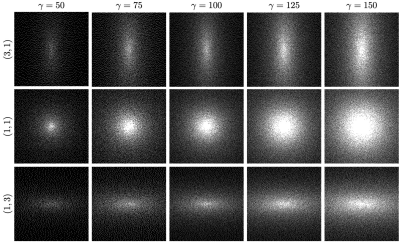 |
Fast Variable Density Poisson-Disc Sample Generation with Directional Variation for Compressed Sensing
Nicholas Dwork1, Corey A. Baron2, Ethan M. I. Johnson3, Daniel O'Connor4, John M. Pauly5, and Peder E.Z. Larson1
1Radiology and Biomedical Imaging, UCSF, San Francisco, CA, United States, 2Robarts Research, Western University, Ontario, ON, Canada, 3Biomedical Engineering, Northwestern University, Evanston, IL, United States, 4Mathematics and Statistics, University of San Francisco, San Francisco, CA, United States, 5Electrical Engineering, Stanford University, Stanford, CA, United States
We present a fast method for generating a variable density poisson-disc sampling pattern. A minimum parameter value is used to create a background grid array for keeping track of those points that might affect any new candidate point; this reduces the number of conflicts that must be checked before acceptance of a new point, thus reducing the number of computations required. We demonstrate the algorithm's ability to generate variable density poisson-disc sampling patterns where the variations in density are a function of direction. We further show that these sampling patterns are appropriate for compressed sensing applications.
|
|||
1191.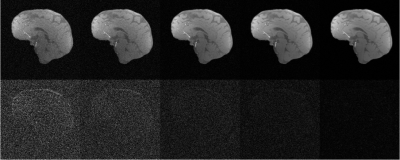 |
Automatic determination of the regularization weighting for low rank reconstruction problems
Gabriel Varela-Mattatall1,2, Corey A Baron1,2, and Ravi S Menon1,2
1Centre for Functional and Metabolic Mapping, Robarts Research Institute, Western University, London, ON, Canada, 2Department of Medical Biophysics, Schulich School of Medicine and Dentistry, Western University, London, ON, Canada
Low rank is an appealing method to reconstruct multiple images that share common properties between them. The highest variance, from a singular value decomposition perspective, comes from acquisition noise; therefore, noise can be tracked and discarded by selecting either the ideal rank or denoising threshold. However, the a priori determination of either of them is still an open question. In this work, we develop a general, non-iterative, fast, and automatic procedure to determine the regularization weighting for low rank reconstruction problems.
|
The International Society for Magnetic Resonance in Medicine is accredited by the Accreditation Council for Continuing Medical Education to provide continuing medical education for physicians.